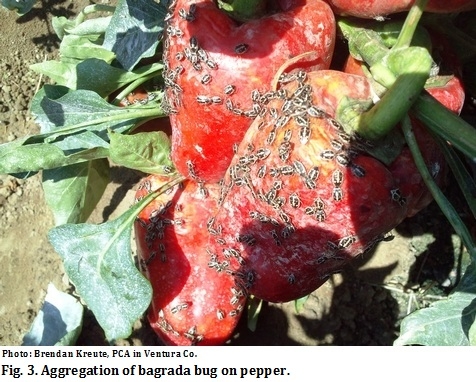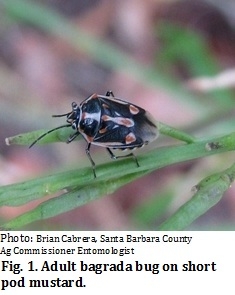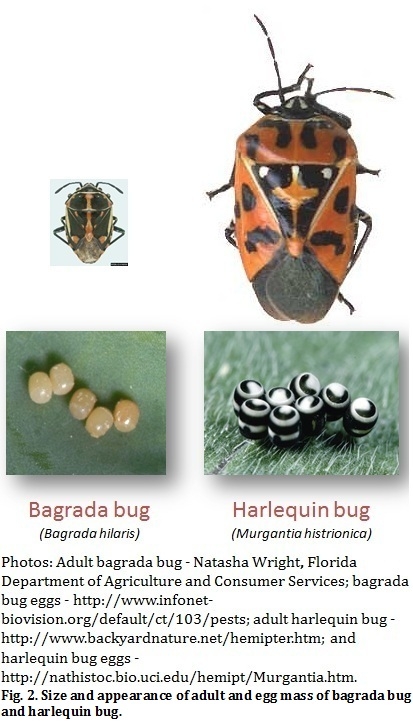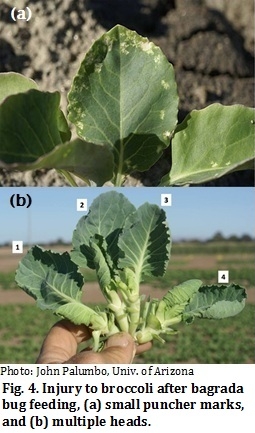ATTN: Recently, bagrada bug adults were found on Chinese or napa cabbage in Santa Cruz County.
Although this bug feeds on a wide range of hosts, we are more concerned because the bug prefers cruciferous hosts (Family: Brassicaceae) including broccoli and cauliflower, which are grown as rotation crops in the Salinas Valley. It is believed that other major crops especially lettuce and spinach are NOT a suitable host for bagrada bug. At the same time, bagrada bug can survive on cruciferous weeds such as mustard species (Brassica sp), wild radish, London rocket, short pod mustard and shepherd’s purse, as well as the insectary crop sweet asylum. Mustard weeds species are very common in the Salinas Valley along ditches, roadsides and even along the edges of agricultural fields. Other species of mustards such as white mustard (Sinapsis alba) and Indian mustard (Brassica juncea) are grown as cover crops. It is clear that given the abundance of mustard family weeds and crops, there is a readily available source of habitat for this insect in the Salinas Valley.
Bagrada bug adult is often confused with harlequin bug. Adult of harlequin bug is orange with black and white marks, whereas bagrada bug adult is black with orange and white marks; and adult harlequin bug is about 3 times larger than bagrada bug (Fig. 2). Eggs of harlequin bug are white with horizontal, black strips, whereas bagrada bug has no strips but has a “dirty” white appearance.
 |
It is believed that bagrada bug overwinters as adult in the cracks and crevices in soil or on plants. Generally, female bug is larger in size than male. Eggs are laid on the underside of leaves, cracks and crevices in soil or on hairy stems. There are five nymphal stages for bagrada bug. Typically, bagrada bug is found in aggregation with various nymphal stages and adult rather than individuals (Fig. 3). Because Salinas Valley has relatively mild temperature through year, it is expected that the development of bagrada bug would be prolonged compared with its populations in the warmer regions where it has been established. This also indicates that, if the bug is established, the number of generations of bagrada bug would be fewer in the Valley than in the warmer locations such as southern California or in the desert regions. Normally, its population size is small during early spring to mid-summer but eventually increases in size during later summer or fall.
At this point, preventing the dispersal of bagrada bug to the Salinas Valley is the key strategy. Growers often move plant materials including transplants to the Valley for production from the regions where the bug has been established. Special care should be given to inspect the plant materials while moving them. Monitoring for bagrada bug during mid-day hours might increase the probability of finding them as the bugs typically hide and stay in the cracks and crevices or on the underside of leaves when the temperature is on the cooler side. Cruciferous weeds in the drains, river bottoms, edges of the field or near residential area increase the risk of establishment. Based on the insecticide efficacy studies conducted in University of Arizona, pyrethroids and neonicotinoids are effective in reducing bagrada bug infestation and injury. For organic growers, none of the products are efficacious but pyrethrin and azidirachtin are suggested.
If you detect bagrada bug in Monterey, Santa Cruz and San Benito Counties, please do not hesitate to contact me at svjoseph@ucdavis.edu or (831) 759-7359.
For more reading, please visit the links:
http://cisr.ucr.edu/bagrada_bug.html
http://www.plantmanagementnetwork.org/pub/php/brief/2010/bagrada/


